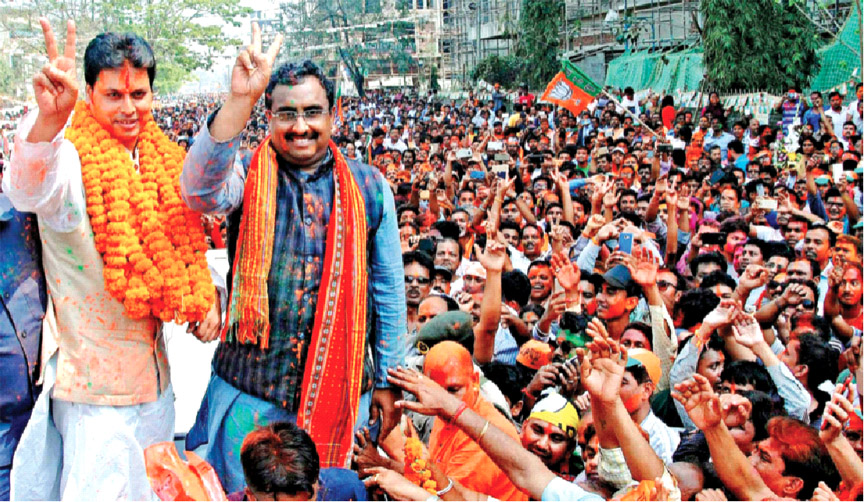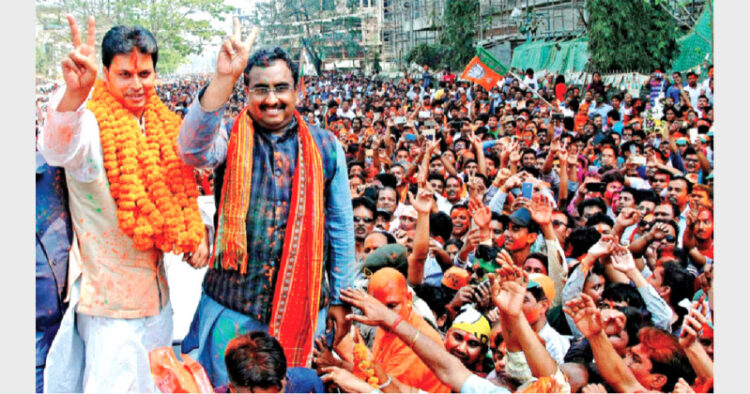 The landslide victory of BJP in Tripura proves that the Left is no more acceptable to the people
The landslide victory of BJP in Tripura proves that the Left is no more acceptable to the people
Swati Deb
A tiny Tripura hamlet of about 800 voters named after a former Post Master from Ghazipur District in Uttar Pradesh – used to swear by Marxists’ ideology.
A graduate from Kailashahar College, 62-year-old Bisheshwar Ahir, a committed CPI-M comrade, says the locality ‘Shivpujan Para’ in Marachara under Dhalai District got the name after his father Shiv Pujan Ahir, who came to this locality as Post Master in 1960s.
Like most villages and smaller towns in Tripura – Marachara township also reflects the scars of the Left regime – as brown haze of dust and poorly maintained roads would greet the visitors. On the eve of voting day, February 18, shopkeepers and auto drivers spoke openly about the ‘wave’ of change that has caught the imagination of voters.
Assembly Polls Result /Report : Why Communists Hate Janjatis?
Assembly Polls Result Report : Voters Endorse Moditva
“People have been voting for CPI-M. Some of them came under compulsion as the Left cadres often indulged in rioting and manhandling those who voted against them. But, what is significant to note this year is that the fear factor has vanished. This means, things can change and hence there is relevance of the BJP slogan ‘Chalo Paltai”,” remarked Kutu Shill, owner of a tailor shop. Such analogy actually would best sum up the election outcome in Tripura.
On the counting day – as big heads rolled – the story was getting clearer by every hour. The long-held Left Front bastion was demolished and the BJP stormed to power ending the monopolistic rule of the communists. BJP president Amit Shah was candid in his sarcasm when he said, the mandate in Tripura has proved that “the Left is not right (not acceptable) to the people”.
“Leftists were shown the doors in West Bengal and today in Tripura,” he said and importantly urged the party workers to show greater zeal to finish off the Marxists in Kerala.
Even Prime Minister Narendra Modi was delighted about the party performance – as BJP was virtually a non-existent force in Tripura even few years back. In 2013 polls, 59 BJP candidates lost their deposits. The perceived ‘Modi wave’ of 2014 had no impact in Manik Sarkar-ruled state. Hence, Modi was right in his analysis: “Jab suraj dubta hae toh Lal rang dikhta hae….. (Sunset is imbued with red colour (the symbol of Left) …and when the sun rises there is a saffron surge). No wonder, Shri Modi’s poetic remarks were received by BJP workers at the party headquarter with thunderous applause.
To analyse political points and factors that actually led to BJP’s historic victory, one needs to have closer scrutiny of the poll strategy. The BJP worked on different poll strategies in Tripura unlike what probably works in Uttar Pradesh or so. Hence, issues like cow vigilantism were not under the political spotlight even as Yogi Adityanath campaigned in important political constituencies.
The BJP’s poll strategy rightly banked on more pressing issues like unemployment, women empowerment and industrialisation. Even the “exploited” state government servants were wooed by none other than Prime Minister Narendra Modi promising that the BJP, if voted to power, will implement 7th Pay Commission’s recommendations.
The BJP leaders realised that voters in Tripura are essentially pro-Left and many have intellectual affinity to Marxism and thus the focus was on breaking the umbilical cord between the voters and pro-Marxist intellectualism.
This brought dividends. Big Marxist heads rolled. Few names include: Janjati leader Agriculture Minister Aghore Deb Barma, who lost a known ‘red fortress’ Asharambari seat to BJP ally IPFT’s Mevar Kumar Jamatia. In Badarghat, CPI-M Rajya Sabha Member Jharna Das Baidya lost to BJP nominee Dilip Sarkar. Similarly, Forest Minister Naresh Chandra Jamatia was humbled in Bagma by senior BJP leader Ram Pada Jamatia. Tripura BJP chief Biplab Kumar Deb also successfully humbled senior Marxist leader and Manik Sarkar’s trusted comrade Amal Chakraborty by a huge margin of 9,549 votes in Banamalipur.
Why the Saffron Surge?
Many factors can be attributed for the landslide victory for BJP and its ally IPFT, but the foremost of all it seems was the swing of over 40 per cent anti-Left vote to the saffron camp. Prime Minister summed it up well saying BJP scaled new height as it was a journey from ‘shunya (Zero) in 2013 to ‘shikhar (top level)’ in 2018. On the vote-count day, if anybody BJP leaders thought should be sent bouquet, they were: Sitaram Yechury and Mamata Banerjee.
The CPI-(M) leader’s ‘friendship’ teletalk to Mamata Banerjee to oppose demonetisation marked the end of Trinamool journey in Tripura. No wonder, loyalties of many Congress voters and leaders first had shifted to Trinamool Congress and ultimately to the BJP.
According to Election Commission, the BJP”s vote share shot up to about 50 per cent in this year”s polls as against 1.5 per cent in 2013. The Congress vote share (read anti-Left) in 2013 was 37 per cent and this significant “anti-Left” vote shifted to the BJP camp by 2016-17 after Sitaram Yechury of CPI-M and Trinamool Congress chief Mamata Banerjee tried to strike a bond to oppose demonetisation move.
This frustrated Trinamool legislators and party workers as they found fighting Left in Tripura would not be possible if there was some kind of alliance between Mamata and Yechury at the national level. The result is nosedive in the CPI-M vote percentage also as from 52 per cent vote share in 2013, the CPI-M could poll only 42 per cent votes in this year”s polls.
Tribal shift
Of various strategies applied by BJP to unseat the Marxists in their renowned citadel—one of the most result oriented cards was BJP’s penetration into Janjati pockets and its right equation with Janjati population. This was given further push by a successful alliance with NC Debbarma-led faction of IPFT. Compared to IPFT, another Janjati-based party led by former militant-turned-neta Bijoy Kumar Hrangkhaw”s Indigenous Nationalist Party of Twipra (INPT) could not strike a chord with the Janjati population.
Nearly 80 per cent of the state”s 37 lakh people are Bengali-speaking Hindus, mostly migrated from Bangladesh. There has been a visible nervousness in the CPI-M camp on erosion of Janjati support base and therefore none other than the Chief Minister Manik Sarkar did try to woo the Bengali voters by telling them repeatedly that the BJP had tied up with a Janjati group and could ‘divide’ the state once they came to power. But the campaign did not impress Bengali voters.
BJP chief Amit Shah has himself taken up this point and pointed out that it is pro-Janjati and pro-poor measures of the Modi government that fetched bigger dividends to help BJP-IPFT sweep all 20 ST reserved seats. Next day in Karnataka, Prime Minister Modi said such a huge mandate in Janjati areas is an answer to the BJP’s critics. “Only integration is the answer to radicalisation,” he said – in reference to the BJP’s campaign that Janjatis and non-Janjatis in Tripura need to show greater empathy towards problems and aspirations of each other. n














Comments